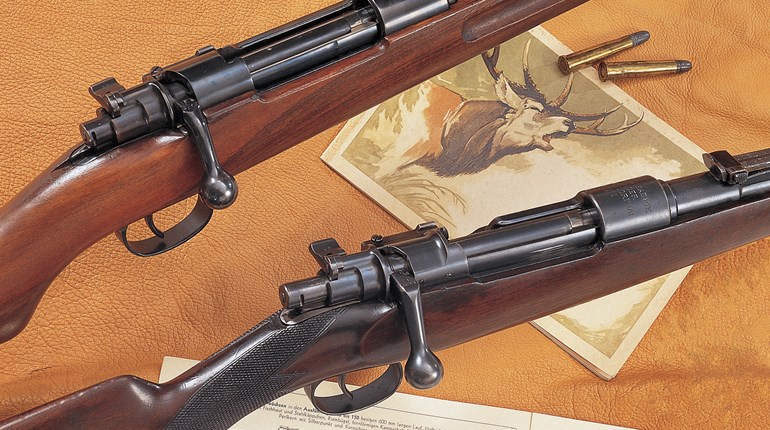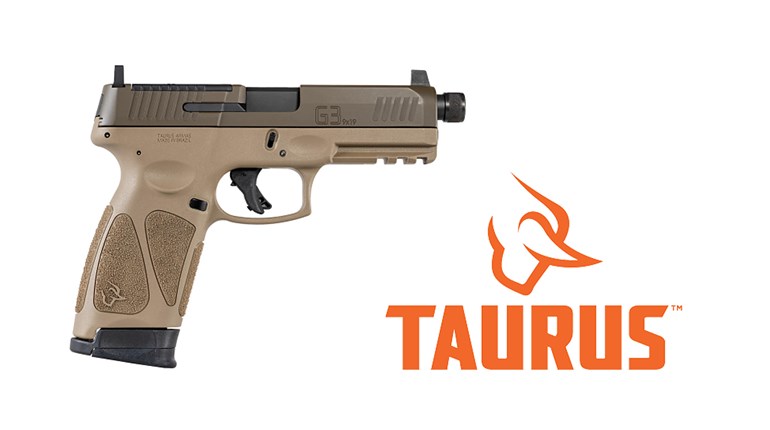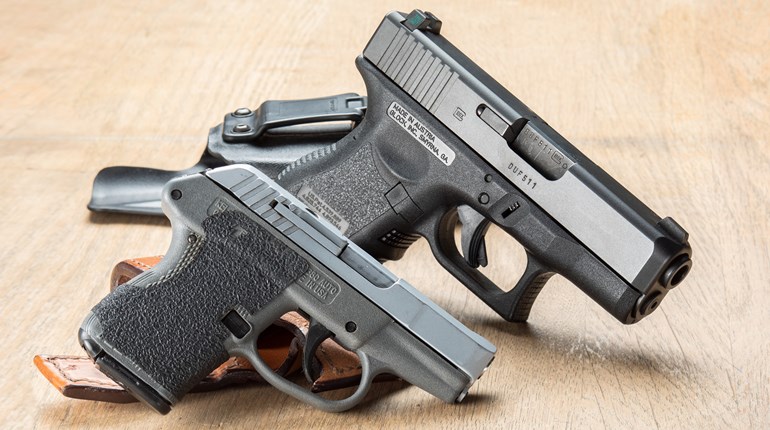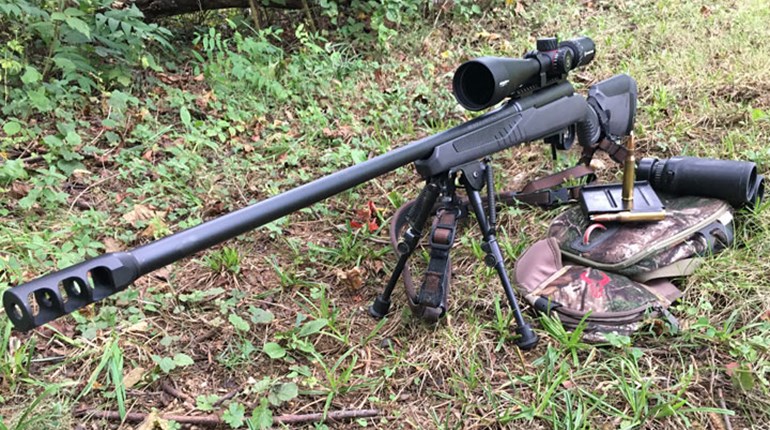
When I think of Steyr-Mannlicher, I picture a company with a fine tradition of producing top-quality rifles for sporting and martial purposes since 1864. But, like another Austrian gunmaker you may have heard of, Steyr-Mannlicher also produces a line of polymer-frame handguns. The new L-A1 from Steyr is a duty-size, recoil-operated pistol available in 9 mm, .40 S&W and .357 SIG. So, what sets this handgun apart from the other polymer handguns in your dealer’s case?
 From a visual and ergonomic standpoint, the most striking and unique feature of the L9-A1 is the shape of the polymer frame. The Steyr’s grip angle is more severe than most other handguns on the market, at a degree that looks almost Luger-ish. The comparison to the P08 Luger is a favorable one, since many consider that design to be one of the most natural pointing of all handguns—not a bad feature to emulate. Another benefit of the torqued grip is it allows the hand to fit further forward on the pistol, which means the grip frame wraps over the top of the shooter’s hand. I don’t think anyone with remotely human anatomy will be “bitten” by the L9-A1’s slide.
From a visual and ergonomic standpoint, the most striking and unique feature of the L9-A1 is the shape of the polymer frame. The Steyr’s grip angle is more severe than most other handguns on the market, at a degree that looks almost Luger-ish. The comparison to the P08 Luger is a favorable one, since many consider that design to be one of the most natural pointing of all handguns—not a bad feature to emulate. Another benefit of the torqued grip is it allows the hand to fit further forward on the pistol, which means the grip frame wraps over the top of the shooter’s hand. I don’t think anyone with remotely human anatomy will be “bitten” by the L9-A1’s slide.
The oversize trigger guard is angled to match the contour of the grip, so everything flows together aesthetically and functionally. Sides of the grip are stippled, and the frontstrap features two finger grooves, which separate the second and third fingers. Another groove descends forward at an angle from the top of the frame and gives the strong-hand thumb a place to rest. As a guy who is always bumping slide stops with his thumb, I’m a fan of this feature. The front of the trigger guard is grooved in case you’re stuck in the 1980s and ride that spot with your weak-hand index finger after drawing from underneath your Member’s Only jacket. Also, the dustcover has an accessory rail for securing a light, laser or other accessory, and I found it to be a good fit for my SureFire flashlight.
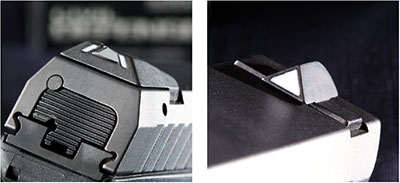 Things like grip angle and fit on a handgun are about like picking out a pair of boots—what feels great to one person may not work for another. Manufacturers do their best to fit the “average hand,” which sometimes fits no one. The L9-A1’s grip sits and shoots pretty naturally in my hand, despite my being accustomed to using more vertical designs. If anything, my natural point-of-aim with this handgun is a bit high, though I found the forward pressure I exerted to put the sights on target to be an aid in combating muzzle rise. I had two other shooters with extensive experience and definite opinions handle and fire this Steyr during testing, and both of them liked the grip geometry.
Things like grip angle and fit on a handgun are about like picking out a pair of boots—what feels great to one person may not work for another. Manufacturers do their best to fit the “average hand,” which sometimes fits no one. The L9-A1’s grip sits and shoots pretty naturally in my hand, despite my being accustomed to using more vertical designs. If anything, my natural point-of-aim with this handgun is a bit high, though I found the forward pressure I exerted to put the sights on target to be an aid in combating muzzle rise. I had two other shooters with extensive experience and definite opinions handle and fire this Steyr during testing, and both of them liked the grip geometry.
 Controls on the L9-A1 are pretty traditional in the modern-handgun sense. There is no manual safety, and the steel slide stop is located above the grip on the left side of the frame. An elongated magazine release is located just below the thumb groove on the grip and it is reversible to meet the preferences of the shooter. The takedown lever is located in the center of the right side of the frame. To fieldstrip the pistol, the unloaded gun is dry-fired in a safe direction and the limited-access lock button is pressed inward. While pressure is maintained on the lock button, the takedown lever is rotated downward, which allows the slide assembly to be removed. The recoil spring and guide rod are removed from the slide, which allows the barrel to slide forward and out. Reversing the process reassembles the pistol, though the lock button need not be depressed.
Controls on the L9-A1 are pretty traditional in the modern-handgun sense. There is no manual safety, and the steel slide stop is located above the grip on the left side of the frame. An elongated magazine release is located just below the thumb groove on the grip and it is reversible to meet the preferences of the shooter. The takedown lever is located in the center of the right side of the frame. To fieldstrip the pistol, the unloaded gun is dry-fired in a safe direction and the limited-access lock button is pressed inward. While pressure is maintained on the lock button, the takedown lever is rotated downward, which allows the slide assembly to be removed. The recoil spring and guide rod are removed from the slide, which allows the barrel to slide forward and out. Reversing the process reassembles the pistol, though the lock button need not be depressed.
The L-A1 line was obviously designed with safety in mind, as it has one active and several passive safety features. The “limited-access lock” allows the user to lock the firing mechanism with one of the small keys included with the handgun—the it can be loaded and unloaded while locked, but it cannot be fired. The safety mechanism also locks the takedown lever so the L-A1 cannot be disassembled while in the “Safe” position. Additionally, the raised center portion of the trigger mechanically locks the trigger until it is engaged by the shooter. Three independent loaded-chamber indicators are also incorporated, so visual and tactile confirmation of the chamber’s condition are always available. A half-moon cutout at the rear of the barrel hood allows the user to see the rim of the cartridge case, if sufficient light is available. Second, the position of the external extractor, located at the rear of the ejection port, changes when the chamber is loaded—a cartridge in the chamber flags the extractor upward and outward. The most unique indicator is a spring-loaded plunger that extends from the top of the bolt face and runs through to the rear of the slide. When a round is in the chamber, the plunger (which looks like a second firing pin) is depressed by the cartridge case and raises a cylindrical indicator at the back of the slide. According to the manual, this plunger runs underneath the rear sight, so owners are warned not to remove the sight from the dovetail.
 Speaking of sights, other than the grip angle, they are the most distinctive feature on this handgun. In a departure from the traditional notch-and-post sights found on most handguns, Steyr employs an unusual pairing of a triangular front and a trapezoidal rear. Looking at the sights, the shooter sees a steel pyramid with a large white insert flanked by the sides of a cutout trapezoid. Unlike most sights, the rear notch actually angles inward and brackets the front sight like a pair of parenthesis. I give the engineers at Steyr credit for trying to build a better mousetrap, but I found these sights very challenging to use for precision work at 25 yards. I have little doubt with traditional sights I could have produced far tighter groups for the accuracy testing of this handgun. That said, I spent a significant amount of time shooting steel and cardboard USPSA-style targets fast and close with the L9-A1, and found these unorthodox sights to be exceptional for the task. The giant front sight stuck out like a sore thumb and was easy to pick up for a flash sight picture. Whether these sights are the right choice for you comes down to personal preference and your intended use for the firearm. Aftermarket sights are reportedly available from Trijicon and XS Sight Systems, and some factory options from Steyr are forthcoming. We’ve had no word on how the loaded-chamber-indicator feature affects the user’s ability to replace the sights.
Speaking of sights, other than the grip angle, they are the most distinctive feature on this handgun. In a departure from the traditional notch-and-post sights found on most handguns, Steyr employs an unusual pairing of a triangular front and a trapezoidal rear. Looking at the sights, the shooter sees a steel pyramid with a large white insert flanked by the sides of a cutout trapezoid. Unlike most sights, the rear notch actually angles inward and brackets the front sight like a pair of parenthesis. I give the engineers at Steyr credit for trying to build a better mousetrap, but I found these sights very challenging to use for precision work at 25 yards. I have little doubt with traditional sights I could have produced far tighter groups for the accuracy testing of this handgun. That said, I spent a significant amount of time shooting steel and cardboard USPSA-style targets fast and close with the L9-A1, and found these unorthodox sights to be exceptional for the task. The giant front sight stuck out like a sore thumb and was easy to pick up for a flash sight picture. Whether these sights are the right choice for you comes down to personal preference and your intended use for the firearm. Aftermarket sights are reportedly available from Trijicon and XS Sight Systems, and some factory options from Steyr are forthcoming. We’ve had no word on how the loaded-chamber-indicator feature affects the user’s ability to replace the sights.
 An often-underappreciated handgun feature is the height of the bore axis. Simple science tells us the higher the bore in relation to the shooter’s grip, the more recoil will leverage the muzzle upward when a shot is fired. All things being equal, the lower the bore axis, the faster your follow-up shots will be. The L-A1 series does far better than most handguns in this department. While this is admittedly a subjective measurement, and though the Steyr’s axis is roughly a quarter-inch higher than that of a Glock Gen 4 G17 at the muzzle, it allows the shooter to maintain a higher grip than on its Austrian competitor. The Steyr’s bore axis is also substantially lower than many other popular duty-size handguns. I found the L-A1 to be very controllable during rapid fire exercises due to this handgun’s bore axis and grip angle.
An often-underappreciated handgun feature is the height of the bore axis. Simple science tells us the higher the bore in relation to the shooter’s grip, the more recoil will leverage the muzzle upward when a shot is fired. All things being equal, the lower the bore axis, the faster your follow-up shots will be. The L-A1 series does far better than most handguns in this department. While this is admittedly a subjective measurement, and though the Steyr’s axis is roughly a quarter-inch higher than that of a Glock Gen 4 G17 at the muzzle, it allows the shooter to maintain a higher grip than on its Austrian competitor. The Steyr’s bore axis is also substantially lower than many other popular duty-size handguns. I found the L-A1 to be very controllable during rapid fire exercises due to this handgun’s bore axis and grip angle.
 At the risk of sounding like a stereotypical gunwriter, the trigger felt lighter than its nearly 7 pounds, perhaps because the high grip puts the trigger finger at a slight mechanical advantage. Trigger pull was very short, with no discernible difference between an initial trigger squeeze and subsequent reset shots, proving it is a true double-action-only trigger. It’s worth noting the trigger safety is wider than what we’ve come to expect from other guns on the market, and essentially constitutes the entire contact surface with the finger. This should result in a more comfortable experience when firing hundreds of rounds during a long range day. If you’ve ever had a blistered trigger finger, you know what I’m talking about. Reliability is obviously a fundamental virtue in a serious handgun and, despite hundreds of rounds of various types and manufacturers churning through this Steyr, it worked without exception throughout testing.
At the risk of sounding like a stereotypical gunwriter, the trigger felt lighter than its nearly 7 pounds, perhaps because the high grip puts the trigger finger at a slight mechanical advantage. Trigger pull was very short, with no discernible difference between an initial trigger squeeze and subsequent reset shots, proving it is a true double-action-only trigger. It’s worth noting the trigger safety is wider than what we’ve come to expect from other guns on the market, and essentially constitutes the entire contact surface with the finger. This should result in a more comfortable experience when firing hundreds of rounds during a long range day. If you’ve ever had a blistered trigger finger, you know what I’m talking about. Reliability is obviously a fundamental virtue in a serious handgun and, despite hundreds of rounds of various types and manufacturers churning through this Steyr, it worked without exception throughout testing.
 So how does the L-A1 stack up against the other polymer-framed 9 mm pistols in the marketplace? When it comes to ergonomics, it’s either going to be love at first grip or not; if it works for you, this aspect is a distinct selling point for the L-A1 series of handguns.
So how does the L-A1 stack up against the other polymer-framed 9 mm pistols in the marketplace? When it comes to ergonomics, it’s either going to be love at first grip or not; if it works for you, this aspect is a distinct selling point for the L-A1 series of handguns.
The sights are also a departure from the mainstream and, if you’re a fan of them, they are another feature that goes in the “buy” column. If you’re not a fan of the trapezoidal sights, they are dovetail mounted should replacement be desired, and other options are available.
Steyr’s cold-hammer-forged barrel uses traditional land-and-groove rifling as opposed to the polygonal rifling found on many popular handguns, which gives the shooter the option of using lead bullets in the factory barrel. With the price and availability of ammo we’ve seen lately, this is a legitimate advantage, especially for those that roll their own ammunition.
If you have young children in the house or are otherwise concerned about safety, the ability to lock this handgun without an external device is a plus, just don’t forget where you put the key.
Finally, we come down to price. With a retail price of $560 and a street price of around $500, the Steyr is less expensive than many of its competitors, while retaining many of the same features. While you shouldn’t put a price on your defensive sidearm, a lower cost of ownership can translate into more ammu- nition for practice or perhaps a training class to help you get acquainted with your chosen pistol.
The L9-A1 offers some truly unique features combined with quality construction and a reasonable price. That, along with Steyr’s reputation for producing quality, innovative firearms— particularly its handguns—is reason enough to give the new duty-size pistol consideration for home defense or everyday carry.



The trigger-mounted safety will allow the pistol to be fired only after the paddle has been depressed.
The oversize trigger guard is angled to match the contour of the grip, so everything flows together aesthetically and functionally. Sides of the grip are stippled, and the frontstrap features two finger grooves, which separate the second and third fingers. Another groove descends forward at an angle from the top of the frame and gives the strong-hand thumb a place to rest. As a guy who is always bumping slide stops with his thumb, I’m a fan of this feature. The front of the trigger guard is grooved in case you’re stuck in the 1980s and ride that spot with your weak-hand index finger after drawing from underneath your Member’s Only jacket. Also, the dustcover has an accessory rail for securing a light, laser or other accessory, and I found it to be a good fit for my SureFire flashlight.

The front sight combines with the rear sight to produce a distinct and unique trapezoid for aiming. The author found this system to aid rapid acquisition, but not precision shooting.

While not the traditional magazine-release shape, the location and activation of this button should be familiar to all pistoleros. It can be oriented for either hand.
The L-A1 line was obviously designed with safety in mind, as it has one active and several passive safety features. The “limited-access lock” allows the user to lock the firing mechanism with one of the small keys included with the handgun—the it can be loaded and unloaded while locked, but it cannot be fired. The safety mechanism also locks the takedown lever so the L-A1 cannot be disassembled while in the “Safe” position. Additionally, the raised center portion of the trigger mechanically locks the trigger until it is engaged by the shooter. Three independent loaded-chamber indicators are also incorporated, so visual and tactile confirmation of the chamber’s condition are always available. A half-moon cutout at the rear of the barrel hood allows the user to see the rim of the cartridge case, if sufficient light is available. Second, the position of the external extractor, located at the rear of the ejection port, changes when the chamber is loaded—a cartridge in the chamber flags the extractor upward and outward. The most unique indicator is a spring-loaded plunger that extends from the top of the bolt face and runs through to the rear of the slide. When a round is in the chamber, the plunger (which looks like a second firing pin) is depressed by the cartridge case and raises a cylindrical indicator at the back of the slide. According to the manual, this plunger runs underneath the rear sight, so owners are warned not to remove the sight from the dovetail.

Finger grooves molded into the grip combined with scored serrations allow firm purchase on the L9-A1, while the pistol’s geometry fosters a high grip for stability.

An accessory rail molded into the frame of the L9-A1 allows attachment of a laser sight, weaponlight or combination of the two.

Next to the takedown lever is the lockout safety. A key, provided by Steyr, is used to manually turn the lever to “S,” locking the trigger and preventing the pistol from being fired or disassembled.

Two of the L9-A1’s three loaded-chamber indicators are the protrusion on the back of the slide and the cutout in the barrel hood.
The sights are also a departure from the mainstream and, if you’re a fan of them, they are another feature that goes in the “buy” column. If you’re not a fan of the trapezoidal sights, they are dovetail mounted should replacement be desired, and other options are available.
Steyr’s cold-hammer-forged barrel uses traditional land-and-groove rifling as opposed to the polygonal rifling found on many popular handguns, which gives the shooter the option of using lead bullets in the factory barrel. With the price and availability of ammo we’ve seen lately, this is a legitimate advantage, especially for those that roll their own ammunition.
If you have young children in the house or are otherwise concerned about safety, the ability to lock this handgun without an external device is a plus, just don’t forget where you put the key.
Finally, we come down to price. With a retail price of $560 and a street price of around $500, the Steyr is less expensive than many of its competitors, while retaining many of the same features. While you shouldn’t put a price on your defensive sidearm, a lower cost of ownership can translate into more ammu- nition for practice or perhaps a training class to help you get acquainted with your chosen pistol.
The L9-A1 offers some truly unique features combined with quality construction and a reasonable price. That, along with Steyr’s reputation for producing quality, innovative firearms— particularly its handguns—is reason enough to give the new duty-size pistol consideration for home defense or everyday carry.

While the magazine release can be located for either right- or left-handed shooters, the takedown lever and slide release are fixed.











